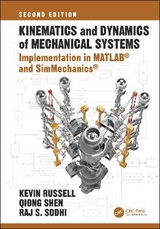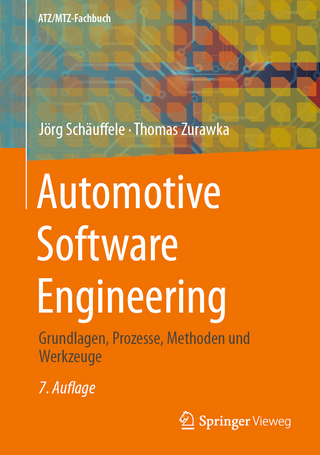
Kinematics and Dynamics of Mechanical Systems
Productivity Press (Verlag)
978-1-4987-2493-7 (ISBN)
- Titel erscheint in neuer Auflage
- Artikel merken
A survey of machine dynamics using MATLAB and SimMechanics, Kinematics and Dynamics of Mechanical Systems: Implementation in MATLAB® and SimMechanics® combines the fundamentals of mechanism kinematics, synthesis, statics and dynamics with real-world applications and offers step-by-step instruction on the kinematic, static, and dynamic analyses and synthesis of equation systems. Written for students with no working knowledge of MATLAB and SimMechanics, this book provides a basic understanding of static and dynamic mechanism analysis, moves beyond conventional kinematic concepts—factoring in adaptive programming, 2D and 3D visualization, and simulation, and equips readers with the ability to readily analyze and design mechanical systems.
Bridging the gap between theory and application, this book:
Introduces the fundamental, kinematic, and mechanical concepts
Presents the displacement, velocity and acceleration analysis of the plan and function generation (concepts in a branch of kinematics called synthesis) of planar four-bar mechanisms
Explores the static and dynamic force analysis of the planar four-bar, slider-crank, geared five-bar, Watt II and Stephenson III mechanisms
Discusses gear and radial cam systems
Describes the displacement velocity and acceleration analysis of the spatial RRSS, RSSR and 4R spherical mechanisms
Includes the forward and inverse kinematic analysis of industrial robots including the Cartesian, cylindrical, spherical, and articulated and SCARA robots
Considers the programmable quantitative methods for kinematic analysis and synthesis
Kinematics and Dynamics of Mechanical Systems: Implementation in MATLAB® and SimMechanics® provides an introduction to kinematics, presents the foundational concepts in mechanism design and analysis, and gives readers the ability to effectively implement existing mechanical system designs for a variety of applications.
Kevin Russell, PhD, PE, is an adjunct professor in the Department of Mechanical and Industrial Engineering at New Jersey Institute of Technology. Formerly, Dr. Russell was a senior mechanical engineer at the U.S. Army Research, Development and Engineering Center at Picatinny, New Jersey. His responsibilities included the utilization of computer-aided design and modeling and simulation tools for small and medium-caliber weapon-system improvement, concept development, and failure investigations. A registered professional engineer in New Jersey, he holds several small and medium-caliber weapon-system patents and has published extensively in engineering journals in the areas of kinematic synthesis, theoretical kinematics, and machine design. Qiong "John" Shen, PhD, is an independent consultant at Softalink LLC, cofounder and president of a privately held data analytics company, and an adjunct professor in the department of electrical and computer engineering at New Jersey Institute of Technology. Dr. Shen obtained his Ph.D. degree by successfully completing National Science Foundation-funded research which also resulted in a U.S. patent. He was an engineering manager at Emerson Network Power in charge of supervisory control and data acquisition systems of critical facilities such as healthcare and datacenter. Dr. Shen has been actively involved in extensive academic research in robotics and mechanism synthesis. Raj S. Sodhi, PhD, PE, is a professor in the department of mechanical and industrial engineering at New Jersey Institute of Technology. Dr. Sodhi has more than 30 years of experience in research and education related to mechanical design, mechanisms synthesis and manufacturing engineering, and is the author or coauthor of more than 100 refereed papers. He was awarded the Society of Manufacturing Engineering’s University Lead Award. He also received the N. Watrous Procter & Gamble Award from the Society of Applied Mechanisms and Robotics, and the Ralph R. Teetor New Engineering Educator Award from the Society of Automotive Engineers.
Introduction to Kinematics
Kinematics
Kinematic Chains and Mechanisms
Mobility, Planar and Spatial Mechanisms
Types of Mechanism Motion
Kinematic Synthesis
Units and Conversions
Software Resources
Summary
References
Additional Reading
Mathematical Concepts in Kinematics
Introduction
Complex Numbers and Operations
Vector and Point Representation
Linear Simultaneous Equations, Matrices, and Matrix Operations
Intermediate and Total Spatial Motion
General Transformation Matrix
Summary
References
Additional Reading
Fundamental Concepts in Kinematics
Types of Planar and Spatial Mechanisms
Links, Joints, and Mechanism Mobility
Number Synthesis
Grashof’s Criteria and Transmission Angle
Circuit Defect
Mechanism Inversion
Passive Degree of Freedom and Paradoxes
Summary
References
Kinematic Analysis of Planar Mechanisms
Introduction
Numerical Solution Method for Two Simultaneous Equations
Link Velocity and Acceleration Components in Planar Space
Four-Bar Mechanism Analysis
Slider-Crank Mechanism Analysis
Geared Five-Bar Mechanism Analysis
Watt II Mechanism Analysis
Stephenson III Mechanism Analysis
Time and Driver Angular Velocity
Mechanism Configurations
Constructing Cognates
Planar Mechanism Kinematic Analysis and Modeling in SimMechanics®
Summary
References
Additional Reading
Dimensional Synthesis
Introduction
Branch and Order Defects
Planar Four-Bar Motion Generation: Three Precision Positions
Order- and Branch-Defect Elimination
Path Generation versus Motion Generation
Stephenson III Motion Generation: Three Precision Positions
Planar Four-Bar Function Generation: Three Precision Points
Planar Four-Bar Function Generation: FSPs and MSPs
Mechanism Dimensions: From Dimensional Synthesis to Kinematic
Summary
References
Additional Reading
Static Force Analysis of Planar Mechanisms
Introduction
Static Loading in Planar Space
Four-Bar Mechanism Analysis
Slider-Crank Mechanism Analysis
Geared Five-Bar Mechanism Analysis
Watt II Mechanism Analysis
Stephenson III Mechanism Analysis
Planar Mechanism Static Force Analysis and Modeling in SimMechanics®
Summary
References
Additional Reading
Dynamic Force Analysis of Planar Mechanisms
Introduction
Dynamic Loading in Planar Space
Four-Bar Mechanism Analysis
Slider-Crank Mechanism Analysis
Geared Five-Bar Mechanism Analysis
Watt II Mechanism Analysis
Stephenson III Mechanism Analysis
Mass Moment of Inertia and Computer Aided Design Software
Planar Mechanism Dynamic Force Analysis and Modeling in SimMechanics®
References
Additional Reading
Design and Kinematic Analysis of Gears
Introduction
Gear Types
Spur-Gear Nomenclature and Relationships of Mating Gears
Helical-Gear Nomenclature
Gear Kinematics
Summary
References
Additional Reading
Design and Kinematic Analysis of Disk Cams
Introduction
Follower Types
Follower Motion
Disk Cam Design and Pressure Angle
Summary
References
Additional Reading
Kinematic Analysis of Spatial Mechanisms
Introduction
RRSS Mechanism Analysis
RSSR Mechanism Analysis
Four-Revolute Spherical Mechanism Analysis
Planar Four-Bar Kinematic Analysis Using RRSS and RSSR Kinematic Equations
Spatial Mechanism Kinematic Analysis and Modeling in SimMechanics®
Summary
References
Introduction to Robotic Manipulators
Introduction
Terminology and Nomenclature
Robotic Manipulator Mobility and Types
The General Transformation Matrix
Forward Kinematics
Inverse Kinematics
Robotic Manipulator Kinematic Analysis and Modeling in SimMechanics®
Summary
References
Additional Reading
Appendices
| Zusatzinfo | 3/16- New Version Date 20160224; 389 lines/4686 total equations; 212 Tables, black and white; 409 Illustrations, black and white |
|---|---|
| Verlagsort | Portland |
| Sprache | englisch |
| Maße | 178 x 254 mm |
| Gewicht | 975 g |
| Themenwelt | Technik ► Fahrzeugbau / Schiffbau |
| Technik ► Maschinenbau | |
| ISBN-10 | 1-4987-2493-0 / 1498724930 |
| ISBN-13 | 978-1-4987-2493-7 / 9781498724937 |
| Zustand | Neuware |
| Haben Sie eine Frage zum Produkt? |
aus dem Bereich



